Fauna and Flora of Cape Tribulation and the Daintree Rainforest
Fauna (continued)
Invertebrates - Insects
Ulysses butterfly
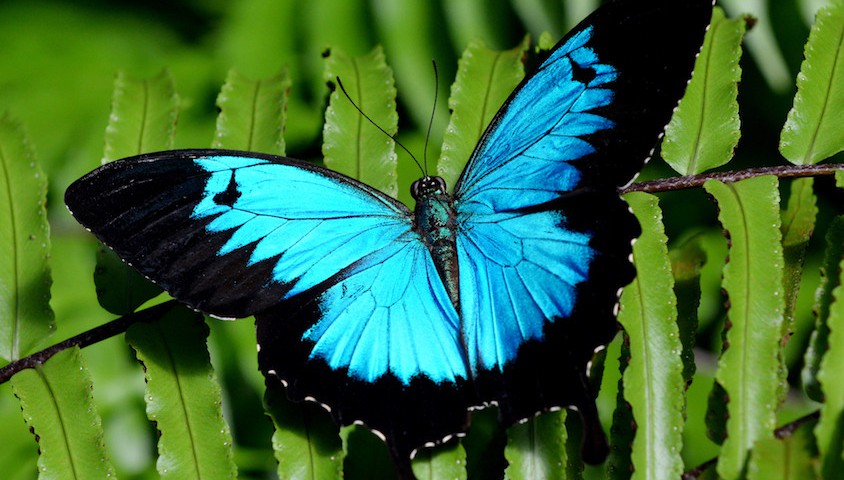 There is high species diversity in the insects of Far North Queensland's lowland rainforest, including the Daintree area. These species include ants, bees, wasps, flies, butterflies, moths, beetles, grasshoppers, crickets, cockroaches (native and introduced), katydids, stick insects, and true bugs, and some of the most beautiful butterflies in the world, such as the Ulysses butterfly (Papillio ulysses. Of the insects, the most common and varied are the beetles (order Coleoptera) (There may be as many as several thousand species.) Beetles in the Daintree rainforest come in an amazing range of sizes, shapes, colours, and patterns. Many local beetles are beautiful, with brightly-coloured or or iridescent carapaces. Although there is high species diversity in this area, actual insect numbers for many species tend to be quite low. This is especially true of some introduced pest species like fleas, which requires a high population density of vector animals like dogs, cats, and rats to spread. So, while a lot of people in the inhabited areas of the Daintree area have dogs, very few of those dogs have fleas (A flea collar on a dog or cat is a rare sight here!). None of the insects in the Daintree is dangerous to humans, although some kinds of flies, such as tabanids and sandflies, common here because of the high humidity, can be a nuisance as their bites can cause very itchy reactions in people with sensitive skin. (If that's you, bring insect repellent!). Mosquitoes, which also bite, sometimes carry human diseases like dengue fever, Ross River fever, and malaria. Don't worry too much, though - most mosquito-borne diseases in Far North Queensland are spread by mosquitoes which have come in contact with people returning from overseas, and your chances of catching a serious disease from a mosquito bite are actually pretty low.
There is high species diversity in the insects of Far North Queensland's lowland rainforest, including the Daintree area. These species include ants, bees, wasps, flies, butterflies, moths, beetles, grasshoppers, crickets, cockroaches (native and introduced), katydids, stick insects, and true bugs, and some of the most beautiful butterflies in the world, such as the Ulysses butterfly (Papillio ulysses. Of the insects, the most common and varied are the beetles (order Coleoptera) (There may be as many as several thousand species.) Beetles in the Daintree rainforest come in an amazing range of sizes, shapes, colours, and patterns. Many local beetles are beautiful, with brightly-coloured or or iridescent carapaces. Although there is high species diversity in this area, actual insect numbers for many species tend to be quite low. This is especially true of some introduced pest species like fleas, which requires a high population density of vector animals like dogs, cats, and rats to spread. So, while a lot of people in the inhabited areas of the Daintree area have dogs, very few of those dogs have fleas (A flea collar on a dog or cat is a rare sight here!). None of the insects in the Daintree is dangerous to humans, although some kinds of flies, such as tabanids and sandflies, common here because of the high humidity, can be a nuisance as their bites can cause very itchy reactions in people with sensitive skin. (If that's you, bring insect repellent!). Mosquitoes, which also bite, sometimes carry human diseases like dengue fever, Ross River fever, and malaria. Don't worry too much, though - most mosquito-borne diseases in Far North Queensland are spread by mosquitoes which have come in contact with people returning from overseas, and your chances of catching a serious disease from a mosquito bite are actually pretty low.
Invertebrates - Arachnids
Spiders
Brown huntsman spider
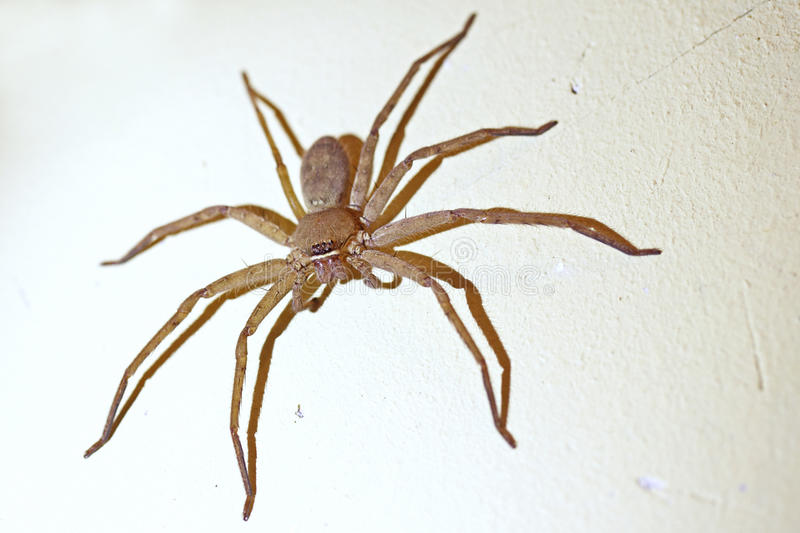 Say "rainforest" to many people and the first thing they think of is "spiders" - scary, hairy spiders the size of your face with venom that is 100% lethal in fifteen minutes or less. The Daintree rainforest has many interesting and often beautiful spiders, from the tiny jumping spiders like the leaf-green, semi-translucent Mopsus mormon to the huge golden orb-weaver (genus Nephila), which weave webs that look like fine strands of metallic gold in sunlight. The most common spiders are various species of huntsman spider, wolf spider, and jumping spider. Most local spiders are not dangerous to humans as they are only mildly venomous and are reluctant biters. Australia's most-dangerous species, the redback spider (Lactrodectus hasseltii), a close relative of the north American black widow spider, and funnel web spiders (genus Hadronyche) are seldom seen in this area. The most frequently-seen spiders are the huntsman spiders. These fascinating animals, which come in a veriety of species are mostly solitary hunters, but one species, the social huntsman, Delena cancerides live in complex family groups of up to 150 members led by a dominant matriarch. Spiderlings remain with their mother until they reach sexual maturity at about one year of age.
Say "rainforest" to many people and the first thing they think of is "spiders" - scary, hairy spiders the size of your face with venom that is 100% lethal in fifteen minutes or less. The Daintree rainforest has many interesting and often beautiful spiders, from the tiny jumping spiders like the leaf-green, semi-translucent Mopsus mormon to the huge golden orb-weaver (genus Nephila), which weave webs that look like fine strands of metallic gold in sunlight. The most common spiders are various species of huntsman spider, wolf spider, and jumping spider. Most local spiders are not dangerous to humans as they are only mildly venomous and are reluctant biters. Australia's most-dangerous species, the redback spider (Lactrodectus hasseltii), a close relative of the north American black widow spider, and funnel web spiders (genus Hadronyche) are seldom seen in this area. The most frequently-seen spiders are the huntsman spiders. These fascinating animals, which come in a veriety of species are mostly solitary hunters, but one species, the social huntsman, Delena cancerides live in complex family groups of up to 150 members led by a dominant matriarch. Spiderlings remain with their mother until they reach sexual maturity at about one year of age.
Other Arachnids and Myriapods
Paralysis tick
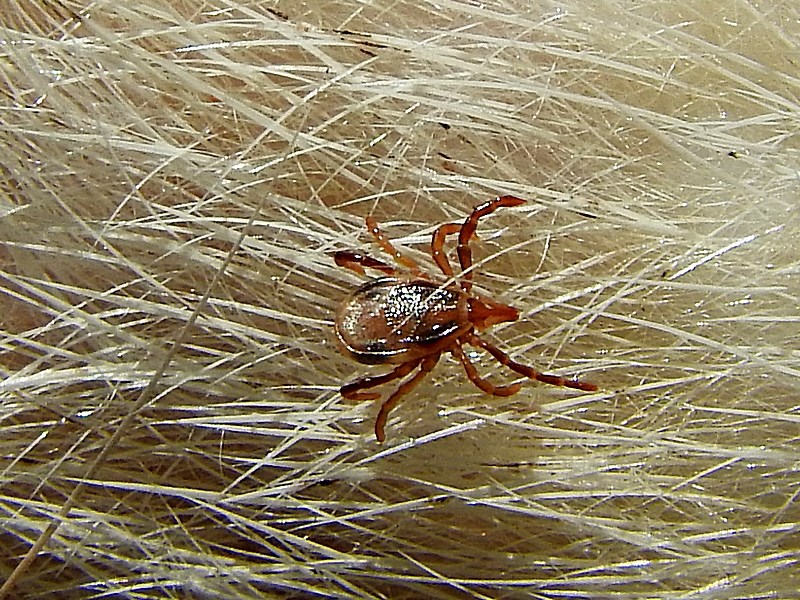 Other arachnids in the Daintree area include scorpions, ticks, mites, centipedes, and millipedes. You will occasionally encounter a velvet worm (Onychophora - not worms at all, but more like primitive arthropods). Of all these species, only one - the paralysis tick, Ixodes holocyclus is dangerous to humans and other mammals. Their saliva is neurotoxic and can cause paralysis and allergic reactions. Tick paralysis is a leading cause of death in flying foxes, who pick up the ticks from vegetation when they come down to feed. This is a particularly serious problem when the flying foxes are mothers with dependent babies.
Other arachnids in the Daintree area include scorpions, ticks, mites, centipedes, and millipedes. You will occasionally encounter a velvet worm (Onychophora - not worms at all, but more like primitive arthropods). Of all these species, only one - the paralysis tick, Ixodes holocyclus is dangerous to humans and other mammals. Their saliva is neurotoxic and can cause paralysis and allergic reactions. Tick paralysis is a leading cause of death in flying foxes, who pick up the ticks from vegetation when they come down to feed. This is a particularly serious problem when the flying foxes are mothers with dependent babies.
Invertebrates - Snails and Slugs
Tree snails
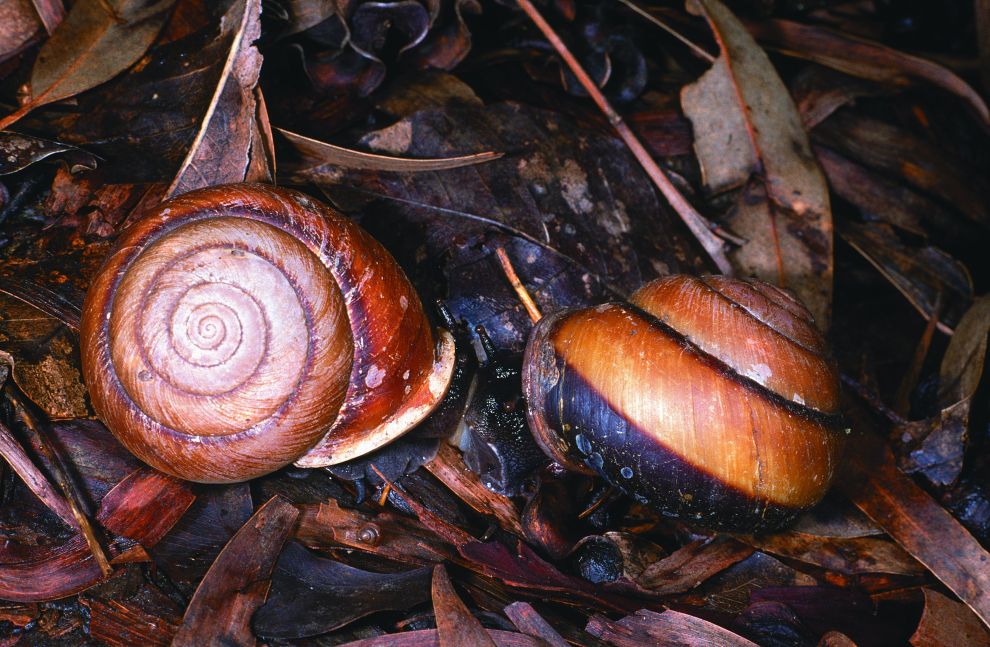 The Daintree rainforest has a very diverse land snail population, including some species of arboreal snails. This diversity is reflected in wide variety of shell shapes, sizes, and colours. There are also a number of species of slugs and semi-slugs (snails with very small shells), some of them very colourful. Interestingly enough, the most common garden snail in the world, Cornu aspersum (formerly Helix aspersa) is rarely if ever found here.
The Daintree rainforest has a very diverse land snail population, including some species of arboreal snails. This diversity is reflected in wide variety of shell shapes, sizes, and colours. There are also a number of species of slugs and semi-slugs (snails with very small shells), some of them very colourful. Interestingly enough, the most common garden snail in the world, Cornu aspersum (formerly Helix aspersa) is rarely if ever found here.
Invertebrates - Worms
Giant blue earthworm
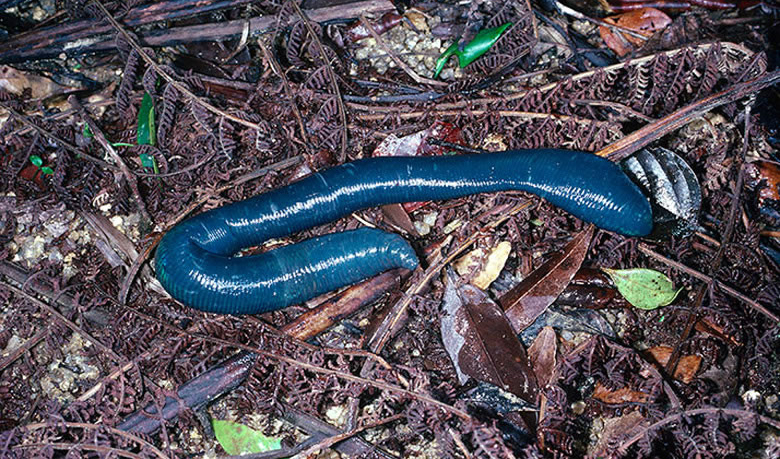 The Daintree lowland rainforest, along with parts of the nearby mountains, has a variety of types of flatworms (Platyhelminthes), earthworms (Annelida), and leeches (which are a type of parasitic earthworm which subsists entirely on blood). The most interesting (and largest) earthworm in the Daintree area is the giant blue earthworm Terriswalkeris terraereginae . It can grow up to two metres in length. Unfortunately very little is actually known about local native earthworm species - and the degree to which introduced worms (through introduced soil and “worm farms”) are having an impact on them.
The Daintree lowland rainforest, along with parts of the nearby mountains, has a variety of types of flatworms (Platyhelminthes), earthworms (Annelida), and leeches (which are a type of parasitic earthworm which subsists entirely on blood). The most interesting (and largest) earthworm in the Daintree area is the giant blue earthworm Terriswalkeris terraereginae . It can grow up to two metres in length. Unfortunately very little is actually known about local native earthworm species - and the degree to which introduced worms (through introduced soil and “worm farms”) are having an impact on them.

